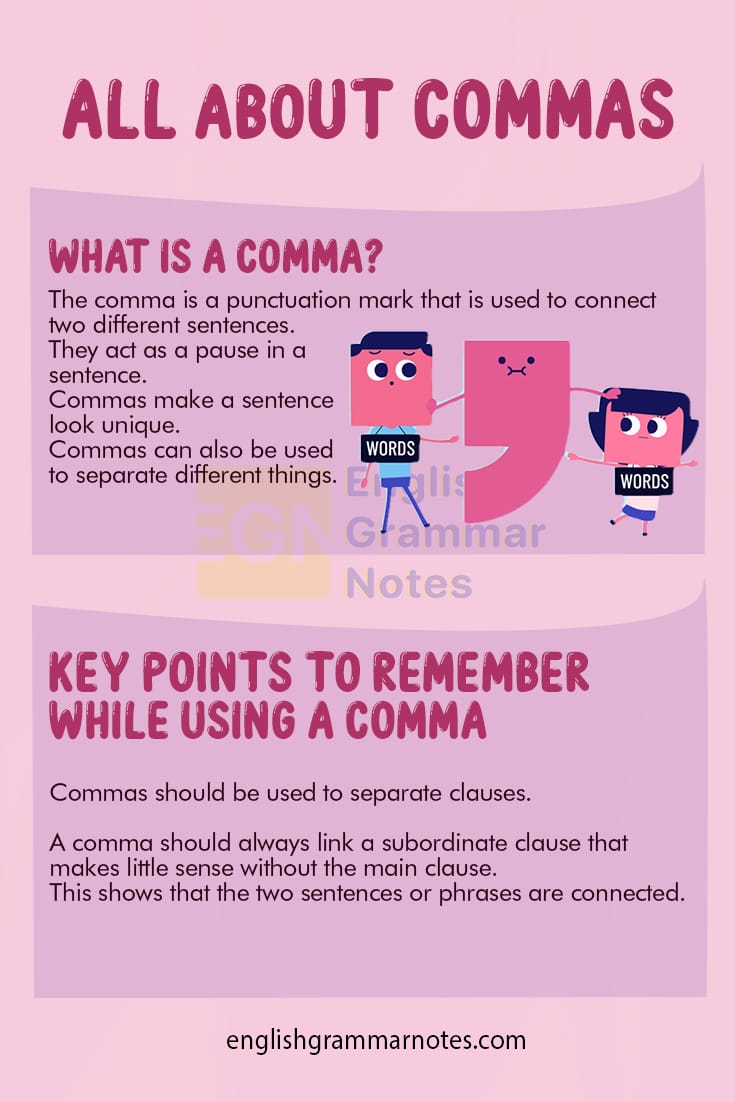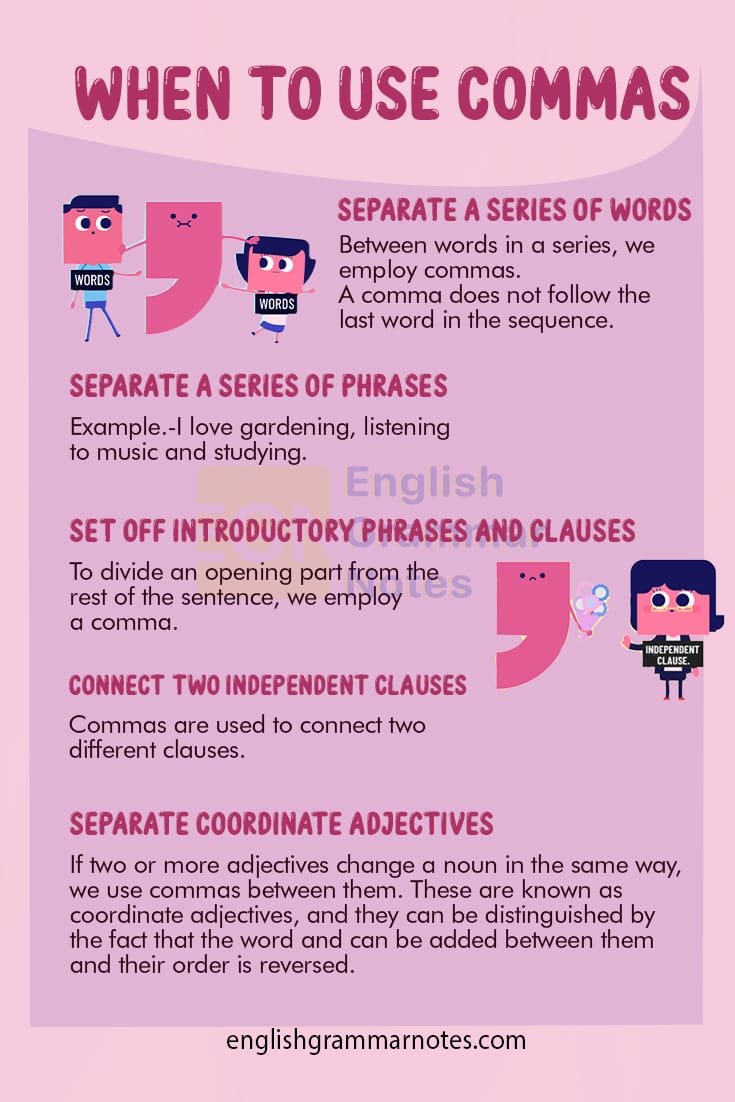Comma: Who doesn’t know about commas? Everyone who knows English knows about commas. The comma is one of the common and most used punctuation marks used in English writing. But Most people use commas without knowing where to use them and where not to. I’m writing this to tell what exactly is a comma, where and where not to use commas.
Study the most important English Vocabulary Words identified by our experts and learn the right vocabulary to use in your day to day conversations.
- What is a Comma?
- Why Are Commas Used?
- When to Use Commas?
- When not to Use a Comma?
- Common Mistakes with a Comma
What is a Comma?
The comma is a punctuation mark that is used to connect two different sentences. They act as a pause in a sentence and help read two separated lines, phrases or ideas together. Commas make a sentence look unique. It can also be said as a small break between sentences.
Commas can also be used to separate different things. Suppose if you are writing about ten books in a sentence, you can’t write them all together. You will use commas to separate them because they are different books.
The serial comma is the most significant distinction between American and British English in comma usage (or Oxford comma in the UK). Serial commas are most commonly used in all lists in the United States. On the other hand, Oxford commas are exclusively used in the United Kingdom when the meaning of the items in the list is unclear. Here’s an example of when the serial/Oxford comma would be used in both American and British English:
I am studying with my friends, Hailey and Justin.
We’ll use the following example to show how American and British writers might employ the serial or Oxford comma differently:
British Example
My favourite colours are red, black, blue and purple.
You have English, maths and science tests tomorrow.
She bought a pen, paper, pencil, an eraser and gifts.
American Example
My favourite colours are red, black, blue and purple.
You have English, maths and science tests tomorrow.
She bought a pen, paper, pencil, an eraser and gifts.
Key points to remember while using a comma
The most important thing to keep in mind when using commas in sentences is that they should be used to separate clauses. If you have more than one clause in a statement, you most likely need to employ a comma (unless you have another more appropriate punctuation mark to replace it).
A comma should always link a subordinate clause that makes little sense without the main clause. This shows that the two sentences or phrases are connected. If your subordinate clause is in the middle of the main clause, you should use two commas, one before and one after the subordinate clause. Of course, commas should be used to separate items in a list. Just keep in mind the differences between a serial and an Oxford comma.

Why Are Commas Used?
- Commas are used to separate a group of words.
- To put a stop to a sequence of phrases
- to join two clauses that aren’t related
- To make beginning phrases or clauses stand out
- Used after the first few words of a phrase.
- To make the parenthetical parts stand out
- To distinguish between coordinate adjectives
- To distinguish the quoted sections
- To set off terms to provide a sense of contrast
- To avoid any misunderstandings
- To set off utterances that break the flow of a sentence
- To distinguish dates, years, and addresses.
- To differentiate between a statement and a tag question.
When to Use Commas?
Separate a series of words
Between words in a series, we employ commas. A comma does not follow the last word in the sequence.
Example:
He had a black, long and a nice umbrella.
Do you want a pen, paper and eraser?
She had long, thick and strong hair.
Separate a series of phrases
Example:
I love gardening, listening to music and studying.
She loves shopping, cooking and playing games.
He studied, learned and understood things.
Robin loves dancing, singing and modelling.
Connect two independent clauses
Commas are used to connect two different clauses.
Example:
He was very naughty, so his parents sent him to the hostel.
She was very tired, so she took a nap.
She was invited to a party, so she went to buy new clothes.
She had a test after two days, so she studied very hard.
Set off introductory phrases and clauses
To divide an opening part from the rest of the sentence, we employ a comma.
Example:
As the day came to an end, the teacher explained the last topic.
After finally reaching the town, we went to find the room.
After waking up, I started studying.
After certain words that introduce a sentence
Example:
I am not going to leave this place at any cost.
Hey, how can I help you?
No, sorry, it is not available.
Hello, my name is Pranav.
Separate the parenthetical elements
A parenthetical element contains a lot of information that, if removed, does not change the meaning of the sentence.
Example:
Gardening, the best thing, is my favourite hobby.
Cricket, the most popular game, is good for our health.
My neighbour, always angry and sad, lives alone.
Separate coordinate adjectives
If two or more adjectives change a noun in the same way, we use commas between them. These are known as coordinate adjectives, and they can be distinguished by the fact that the word and can be added between them and their order is reversed.
Example:
He is a motivator, a hardworking person.
Those people felt broken, sad and rejected.
She is a strong, a brave person

Separate the quoted part
Example:
She said,” Where are you going?”
Robin said,” What is the class time?”
My mother said,” She will be late today.”
Set off phrases to express contrast
Example:
He is a good lover, but a bad friend.
The past is behind us, the future ahead.
It is not essential but can be used.
Avoid confusion
Example:
For most, it is free of cost.
I saw I was getting late, so I got ready to leave.
Both of them are not the same, and they have different rules and regulations.
It did not feel important, so I ignored it.
Set of expressions that interrupt the sentence flow
Example:
I promise, no matter what, I am with you always.
On the other hand, most of them hate politics.
Separate dates, addresses, years
Example:
She got married on July 5, 2018
Her dad died on Monday, 13 August.
He lives in Downtown, Canada.
My grandfather was born in 1958.
Separate a statement from the tag question
Example:
This is wrong, isn’t it?
It is true, is it?
This will not be ok, won’t it?
We have never talked to her, have you?
There were no people when we were standing there, were there?
When not to Use a Comma?
In the following part, we’ll look at when a comma isn’t necessary. We don’t have enough room to inform you about all the times you shouldn’t use a comma, so we’ll point out the ones when it’s most common. This should prevent you from committing the same errors.
As a general guideline, whenever we employ a comma in a sentence, we should read it aloud and exaggerate the pause where the comma is placed to see if it works. If the comma feels extraneous or detracts from the meaning or tone of the statement, it’s probably best to eliminate it and see if the sentence works better without it.
Common Mistakes with a Comma
With compound verbs
Do not use a comma with compound verbs.
Incorrect: She lets the dog and catfight.
Correct: She lets the dog and catfight.
Incorrect: They would work with her without money.
Correct: They would work with her without money
With subordinate clauses
Commas do not separate subordinate clauses unless they follow a special comma rule, such as being in a series or serving as appositives, nonrestrictive modifiers, or introductory adverb clauses.
Incorrect: I was working hard, so I could get full marks.
Correct: I was working hard so I could get full marks.
Incorrect: She called her so that they could talk in silence.
Correct: She called her so that they could talk in silence.
With noun and adjectives
Incorrect: The green car is very expensive.
Correct: The green car is very expensive.
Incorrect: The yellow umbrella is broken.
Correct: The yellow umbrella is broken.
After the last item in a list
Incorrect: Apples, mangoes, and bananas are my favourite fruits.
Correct: Apples, mangoes, and bananas are my favourite fruits.
Incorrect: Cars, bicycles and buses are modes of transport.
Correct: Cars, bicycles and buses are modes of transport.
When there are only two items on a list
Incorrect: From the market, I wanted to buy a bag and a book.
Correct: From the market, I wanted to buy a bag and a book.
Incorrect: On the way home, I took my phone and charger.
Correct: On the way visiting home, I took my phone and charger